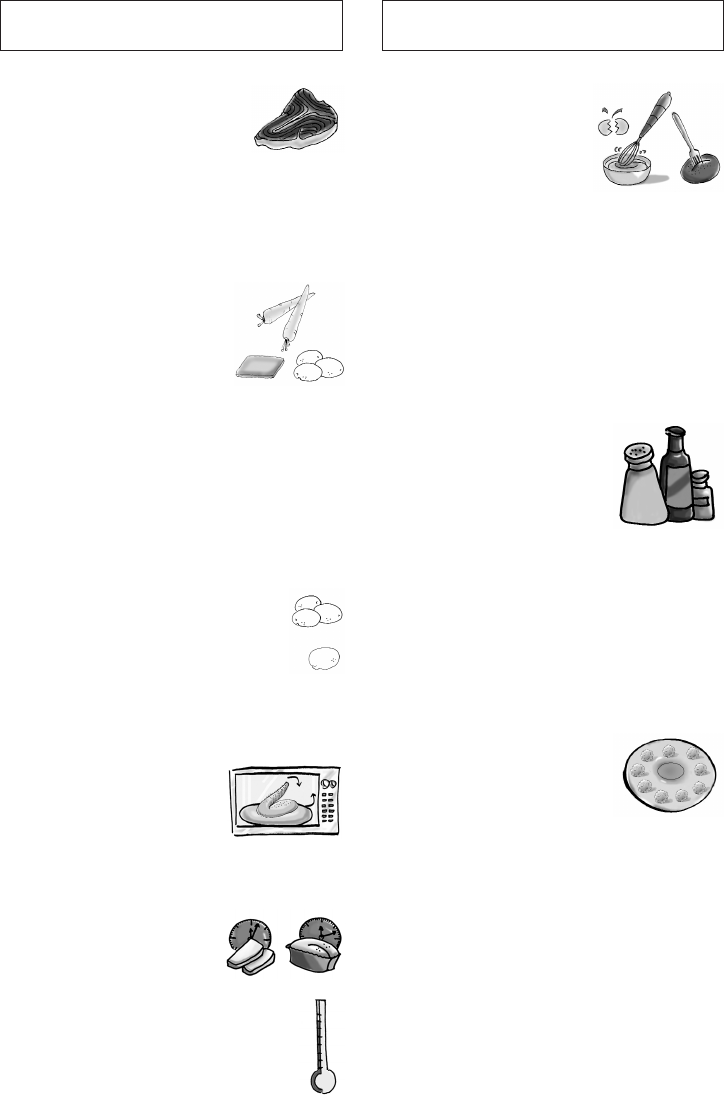
20
Food Characteristics Cooking Techniques
Bone and Fat
Both bone and fat affect cook-
ing. Bones may cause irregu-
lar cooking. Meat next to the
tips of bones may overcook
while meat positioned under a large bone,
such as a ham bone, may be under-
cooked. Large amounts of fat absorb
microwave energy and the meat next to
these areas may overcook.
Density
Porous, airy foods such as
breads, cakes or rolls take
less time to cook than
heavy, dense foods such as
potatoes and roasts. When
reheating donuts or other
foods with different centers be very care-
ful. Certain foods have centers made with
sugar, water, or fat and these centers
attract microwaves (For example, jelly
donuts). When a jelly donut is heated, the
jelly can become extremely hot while the
exterior remains warm to the touch. This
could result in a burn if the food is not
allowed to cool properly in the center.
Quantity
Two potatoes take longer to cook
than one potato. As the quantity of
the food decreases so does the
cooking time. Overcooking will
cause the moisture content in the
food to decrease and a fire could result.
Never leave microwave unattended while
in use.
Shape
Uniform sizes heat more
evenly. The thin end of a
drumstick will cook more
quickly than the meaty
end. To compensate for irregular shapes,
place thin parts toward the center of the
dish and thick pieces toward the edge.
Size
Thin pieces cook more
quickly than thick pieces.
Starting Temperature
Foods that are at room temperature
take less time to cook than if they
are chilled, refrigerated, or frozen.
Piercing
Foods with skins or mem-
branes must be pierced
scored or have a strip of
skin peeled before cook-
ing to allow steam to
escape. Pierce clams,
oysters, chicken livers, whole potatoes
and whole vegetables. Whole apples or
new potatoes should have a 1-inch strip
of skin peeled before cooking. Score
sausages and frankfurters. Do not
Cook/Reheat whole eggs with or without
the shell. Steam build up in whole eggs
may cause them to explode, and possibly
damage the oven or cause injury.
Reheating SLICED hard-boiled eggs and
cooking SCRAMBLED eggs is safe.
Browning
Foods will not have the
same brown appearance as
conventionally cooked foods
or those foods which are
cooked utilizing a browning
feature. Meats and poultry
may be coated with browning sauce,
Worcestershire sauce, barbecue sauce or
shake-on browning sauce. To use, com-
bine browning sauce with melted butter or
margarine and brush on before cooking.
For quick breads or muffins, brown sugar
can be used in the recipe in place of
granulated sugar, or the surface can be
sprinkled with dark spices before baking.
Spacing
Individual foods, such as
baked potatoes, cupcakes
and appetizers, will cook more
evenly if placed in the oven
equal distances apart. When
possible, arrange foods in a circular pattern.
F00036L60AP 2004.2.9 16:07 Page 22


















